Scientists have found an ash tree that is fighting back against ash dieback disease, which is devastating tree populations across the UK and much of Europe – this is the first sign of hope that we may be able to restore tree populations by using selective breeding to develop new strains of plants that are tolerant to the fungal disease.
Details on the new discovery – a single tree nicknamed Betty – have been published in a report co-funded by BBSRC (Biotechnology & Biological Sciences Research Council) and DEFRA (Department of the Environment, Fisheries and Rural Affairs).
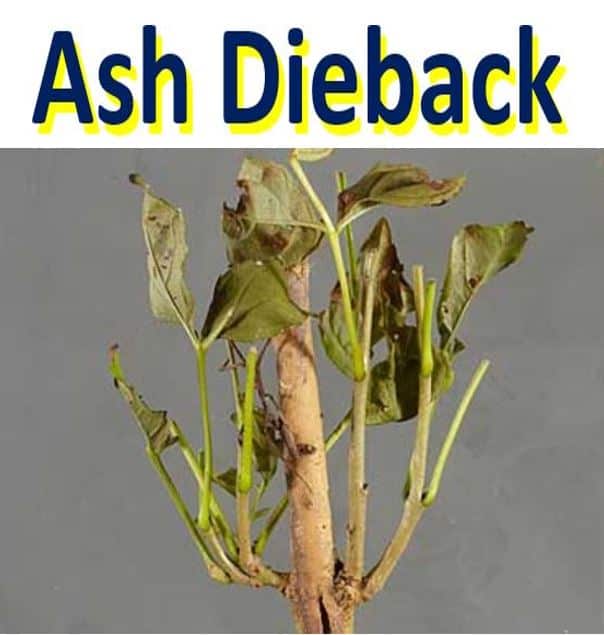 According to the Forestry Commission: “Chalara (ash dieback) causes leaf loss, crown dieback and bark lesions in affected trees. Once a tree is infected the disease is usually fatal, either directly, or indirectly by weakening the tree to the point where it succumbs more readily to attacks by other pests or pathogens, especially Armillaria fungi, or honey fungus.” (Image: forestry.gov.uk)
According to the Forestry Commission: “Chalara (ash dieback) causes leaf loss, crown dieback and bark lesions in affected trees. Once a tree is infected the disease is usually fatal, either directly, or indirectly by weakening the tree to the point where it succumbs more readily to attacks by other pests or pathogens, especially Armillaria fungi, or honey fungus.” (Image: forestry.gov.uk)
Alarming spread of ash dieback disease
Ash dieback is spreading alarmingly across the whole of the United Kingdom. In one woodland in Norfolk, East Anglia, an exceptionally-high number of trees are infected.
However, there are exceptions which show considerably lower levels of infection by the ash dieback fungus. It is here that scientists have discovered Betty as having a surprisingly strong tolerance (resistance) to the disease.
This major breakthrough came after researchers from the government-backed *NORNEX project, led by the John Innes Centre in Norfolk, published their research report into ash dieback disease, also known as Chalara dieback of ash.
* NORNEX is a network of scientists from eleven different research institutions aiming to make tools to help understand how to combat ash dieback, caused by Chalara fraxinea (Hymenoscyphus pseudoalbidus).
Three genetic markers to predict tolerance
The scientists compared the genetic make-up of plants with different levels of resistance to ash dieback disease. They then developed three genetic markers which allowed them to determine whether a or not a tree was likely to be resistant to the disease – even when it was likely to be ‘strongly’ or ‘mildly’ resistant.
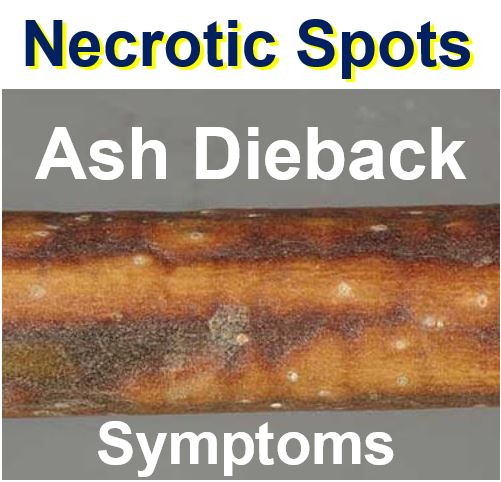 The Royal Horticulutral Society says: “Small lens-shaped lesions or necrotic spots appear on the bark of stems and branches and enlarge to form perennial cankers. The infection may girdle the stem and kill it in a single season. If the bark is peeled, the wood underneath has a brownish to grey discolouration. This discolouration extends beyond the bark necrosis.” (Image: forestry.gov.uk)
The Royal Horticulutral Society says: “Small lens-shaped lesions or necrotic spots appear on the bark of stems and branches and enlarge to form perennial cankers. The infection may girdle the stem and kill it in a single season. If the bark is peeled, the wood underneath has a brownish to grey discolouration. This discolouration extends beyond the bark necrosis.” (Image: forestry.gov.uk)
They found that Betty had incredibly strong tolerance.
DEFRA’s Lords spokesman, Lord Gardiner (Baron Gardiner of Kimble), unveiled the latest findings at the John Innes Centre in Norfolk on Friday. He said:
“This Government has invested more than any other country in research on ash dieback, and today’s breakthrough is an excellent example of how the UK’s cutting-edge science is leading the way to help support tree health.”
“We want to guarantee the graceful ash tree continues to have a place in our environment for centuries to come and this vital work is a major step towards ensuring just that.”
Genetic markers more prevalent in UK
The NORNEX scientists also found that the three genetic markers appear to be more prevalent in British ash trees than in those from several other countries. They do not yet know why, but suggest this should be taken into account when considering future tree development programmes.
Nicola SpenceUK Chief Plant Health Officer (part of DEFRA), said:
“This unprecedented work conducted by British scientists has uncovered an exciting development in tree health.”
“It paves the way for tackling this destructive disease and will help ensure that Britain’s stock of ash trees, and its countryside, remains resilient against pests and disease in the future.”
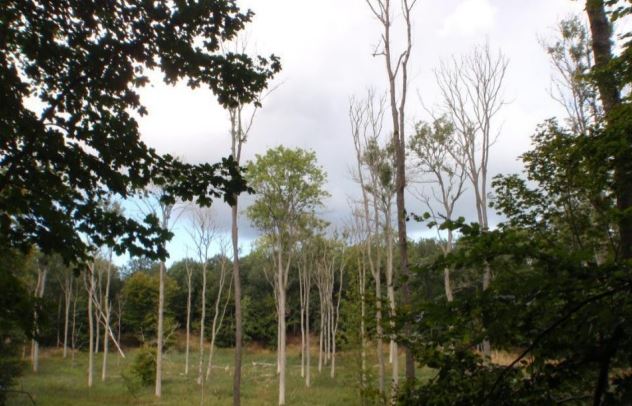 From sixty to 90% of all ash trees in Denmark have observable signs of ash dieback disease. (Image: slideshare.net/ERWilson1/biology-of-chalara-fraxinea)
From sixty to 90% of all ash trees in Denmark have observable signs of ash dieback disease. (Image: slideshare.net/ERWilson1/biology-of-chalara-fraxinea)
Coordinator of the NORNEX consortium, Prof. Allan Downie, who is also Emeritus Fellow at the John Innes Centre, said:
“The identification of genetic markers for trees with low susceptibility to ash dieback is a large first step, one of many that will be needed in the fight to help ash trees survive this disease epidemic.”
“It is astonishing that we have come so far in so short a time, and this success is due to the commitment and collaboration of my many colleagues and the funding they received from BBSRC, DEFRA and NERC.
Chief Executive of the BBSRC, Prof. Melanie Welham, said:
“Working across Government we issued this rapid response to ensure the UK’s excellent plant science base was primed to help combat the threat of ash dieback.”
“Tree pests and pathogens present a significant challenge to our woodlands and habitats, but through fundamental bioscience research we can gain the vital insights needed to help protect the UK’s trees.”
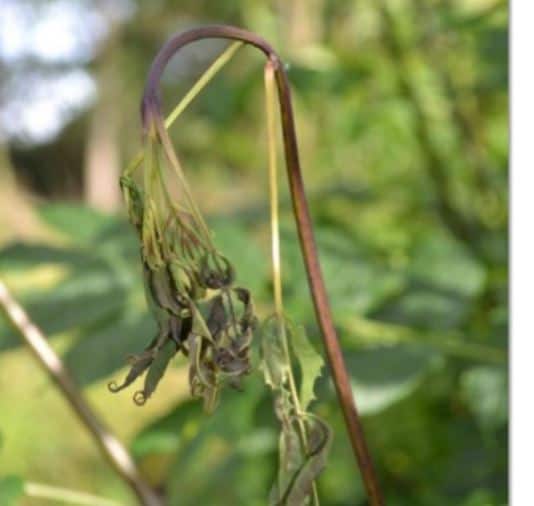 Advanced wilting of ash leaves due to ash dieback disease. (Image: livingashprojecterwilsonlecture/1)
Advanced wilting of ash leaves due to ash dieback disease. (Image: livingashprojecterwilsonlecture/1)
About ash dieback disease
Ash dieback disease, which is devastating ash populations across much of Europe, including the UK, is caused by Hymenoscyphus pseudoalbidus, a fungus.
It is a chronic – long-term – disease of European ash trees which suffer serious leaf loss and crown dieback (top ‘crown’ of the tree loses leaves).
Scientists first described the fungus scientifically under the name Chalara fraxinea in 2006. However, four years later they realized that Chalara fraxinae was just the asexual (anamorphic) stage of this fungus, that was subsequently named Hymenoscyphus pseudoalbidus.
Symptoms of ash dieback disease
The first signs are small necrotic spots that become visible on stems and branches. These grow, resulting in dieback of branches, wilting, and the death of the top section of the crown.
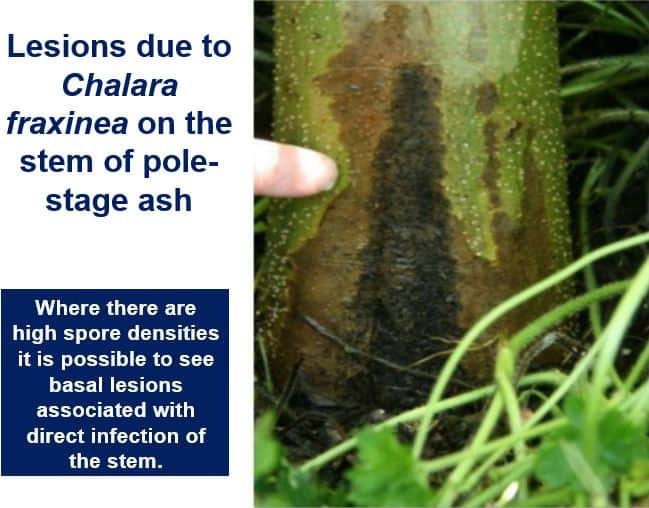 Ash dieback fungal disease, which has devastated tree populations in Scandinavia, is threatening to destroy Britain’s 80 million ash trees. Symptoms of the disease can be visible on stems, leaves, shoots and branches of affected trees. (Image: livingashprojecterwilsonlecture/1)
Ash dieback fungal disease, which has devastated tree populations in Scandinavia, is threatening to destroy Britain’s 80 million ash trees. Symptoms of the disease can be visible on stems, leaves, shoots and branches of affected trees. (Image: livingashprojecterwilsonlecture/1)
In the vast majority of cases the disease is chronic, i.e. the tree continues living, but in an infected state for a very long time. However, sometimes it can kill the tree. Young ash plants are significantly more severely affected. A considerable number of young plants perish within 24 months of symptoms becoming visible.
Although older trees fare better, they also eventually succumb after many seasons of infection.
Ash dieback disease has been around in Europe since the mid-1990s. Since the first case was identified in Poland, a large number of trees, particularly in Eastern and Northern Europe, have been infected.
From sixty to ninety percent of ash trees in Denmark and more the 50% in Sweden have observable damage, while one quarter of all trees in Scandinavia are severely injured.
The first signs of the disease in the UK were discovered in imported nursery plants in 2012. By October of that year it had already spread – two sites of established woodland in East Anglia had infected trees.
OpenAshDieback said, regarding genetic resistance to the disease:
“Research into the genetics of the resistance of ash has shown that resistance does occur in European populations, but, at least for the samples tested, it is neither common nor strong.”
Video – Ash dieback and other threats to UK trees
This BBC News video talks about the danger of ash dieback and other diseases and insects that threaten Britain’s trees. (Video was release one year ago).
